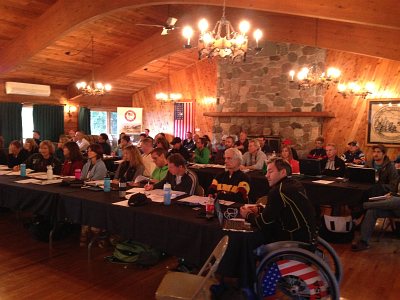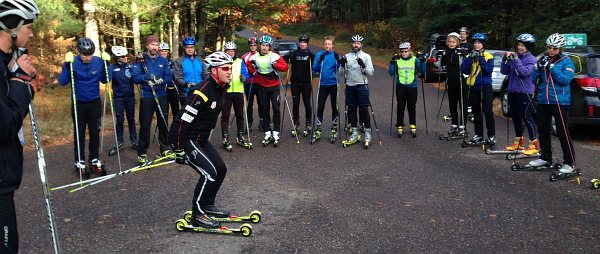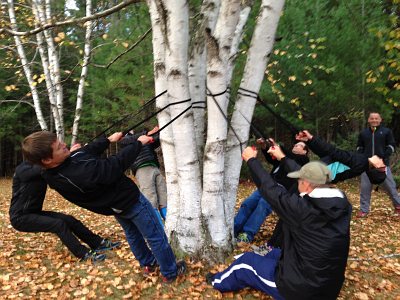CXC Coaches Conference 2013
Fall is the time when skiers start to twitch. Leaves change and fall, temperatures drop, reports of early snow are on the net, and here in the Midwest, with a few snowflakes in the air, it's time to ramp up training. The same can be said of ski coaches. Summer's a memory and all the planning and dry land activities are coming to a close. The last few roller skis (hopefully), into warmer clothes for outside, headlamps coming out, and closing in on a month until West Yellowstone.
 53 coaches from Minnesota, Wisconsin, Michigan, Illinois, and far flung Washington state gathered at the Cable Community Center in lovely downtown Cable, WI for this year's edition of the CXC Coaches Certification Clinic, October 18-20. Fairly evenly divided by gender, the median age leaned more toward AARP than newly minted voters. The clinic was designed with the specific goal of having each of the attendees certified as Level 100 USSA Coaches. This would be epic as only seven had previously been certified this year, throughout the United States.
53 coaches from Minnesota, Wisconsin, Michigan, Illinois, and far flung Washington state gathered at the Cable Community Center in lovely downtown Cable, WI for this year's edition of the CXC Coaches Certification Clinic, October 18-20. Fairly evenly divided by gender, the median age leaned more toward AARP than newly minted voters. The clinic was designed with the specific goal of having each of the attendees certified as Level 100 USSA Coaches. This would be epic as only seven had previously been certified this year, throughout the United States.
CXC Executive Director, Yuiry Gusev, started things off Friday afternoon with a presentation on the importance of training plans and how the cycle of training fit into an athletes year, along with yearly progressions. Both online resources and hard copy gave short and long term plans with implementations discussed, along with adaptations for athletes, and common errors.
Steve Myrland took over later in the afternoon and as a trainer of many athletic teams and progressive thinker about how the body moves and responds to training, he challenged the coaches to think outside the traditional strength box. In doing so he gave examples of how to “turn it down or turn it up” to give each athlete a clear role in avenues of improvement, no matter where their levels. The concept that simple tools, including body weight yield powerful results came through clearly. A progression through the common, but well respected pushup demonstrated how strength can be incorporated across the spectrum and developed through high levels with interest and creativity.
After dinner the day concluded with a presentation by Yuriy around the themes presented in “The Power of Sport”. This talk focused on Olympic ideals, beyond the high end suggested by media, and instead focused on the values of Excellence, Friendship, and Respect; something that all coaches at any level can buy into. Having caught the fever of being a part of the “Team behind the Team”, we left the day inspired and ready to engage the next day.
Saturday was the day some coaches had anticipated for a long time. Late in the morning a 50 item test loomed so all attention was given to Dr. Jim Mullen, sports doc and Elite Wave Birkie skier as we prepared to dive into the manual. Anxiety was either relieved or heightened when he announced the goal of “100% Success Rate!” Three hours later after a intense review, plenty of discussion, tales from the field aplenty, and occasional stretching breaks, all were ready to test. While some online delay was dealt with, soon all were deeply involved in the process with the hushed memory of a collegiate test period. Luckily the well developed and comprehensive manuals were available for consultation and after all was said and done: 100%!, well not the scores, but with all participants meeting the standard.
Lunch tasted mighty good after that episode and along the way USSA Development Coach Bryan Fish joined the proceeding. While all coaches need to have a background in paperwork, meetings, computer skills, and seat work, the essence of what we do is outside, active, and thinking; and that is what the afternoon offered. After writing the Level 100 Manual, Coach Fish has spent the past lifetime or so being in camps with everyone from Master to youth, with a large number of elite athletes thrown in for good measure. He has credentials. He's devoted to enlarging, expanding, and educating the base of skiers in the US, and the dude can move. We were all ears as we progressed through dry land movements building upon the simple to complex theme. Proper running mechanics moved into bounding, hopping, and jumping; again themed around the concept of high levels of athleticism feeding into the specific nature of our sport.

A short drive away we donned the classic roller ski gear to transition to a familiar training method. All that we did dry land became important to ski feel as we again used the rollers to run, bound, hop, skip, and get to the edge of comfort levels. With only a few in the ditch, little skin was lost and we realized that we had a way to go to best the likes of Andy Newell, Simi Hamilton, and Kikkan Randall, three athletes Coach Fish ranks as among the best in the world for ski handling.
After the Saturday dinner we broke into small groups for discussion and questions for the previous presenters about whatever the conversation followed. In my group with Bryan, we were challenged to bring more emotion, commitment, and connections to the athletes we worked with, again framed around the Olympic themes that are inherent in the finest parts of our world wide sport and culture.
 Sunday was the day to advance the basic needs of First Aid and CPR certification. Jon Stone serves as an EMT for the Houghton/Hancock area of Michigan and has a deep well of experience and anecdotes to draw from as he delivered lifesaving material. It also helps that he is a parent of a skier, has attended a number of national ski events, coaches with the Copper Country Ski Tigers Club, and has a wicked sense of humor. Four hours later we had devoured blood-borne pathogens, unblocked airways, delved into diabetes, inhaler protocol, proper management of accident scenes, and pounded the heck out a bunch of manikins, with a little AED work thrown in for good measure.
Sunday was the day to advance the basic needs of First Aid and CPR certification. Jon Stone serves as an EMT for the Houghton/Hancock area of Michigan and has a deep well of experience and anecdotes to draw from as he delivered lifesaving material. It also helps that he is a parent of a skier, has attended a number of national ski events, coaches with the Copper Country Ski Tigers Club, and has a wicked sense of humor. Four hours later we had devoured blood-borne pathogens, unblocked airways, delved into diabetes, inhaler protocol, proper management of accident scenes, and pounded the heck out a bunch of manikins, with a little AED work thrown in for good measure.
Coach Fish finished up the conference with a look at where the US is as a skiing nation. The historical background which now frames the women's success, the World Sprint Championship of Kikkan Randall, and all the other advancements made by US Nordic skiers are carefully advanced through goal setting, as staff, athletes, and programs are constantly moving and changing. Included in closing comments were the always nascent thought, “Where do we go from here?”
Indeed, you'll see the wildly colored Bjorn Dahlie hats with the Level 100 certification patch on the trails this winter, indicative of a sense of the future, empowered to grow and challenge, working toward the fulfillment our wonderful sport offers. While we have enjoyed growth and success as a skiing nation in the past with coaches grown organically and pathways taken haphazardly through the coaching ranks, now we have a system in place mirroring other sports in the US and among the skiing nations worldwide. The challenge offered in closing was to have each of the newly minted Level 100 coaches bring back one new coach next year, as this year's graduating class moves forward in skills and sophistication toward the Level 200 rank. Next year...next year, maybe you?
All levels of USSA coaching may be accessed online, as well as the testing and additional certification necessary, first aid, CPR, background checks, along with attending a clinic. While that may fit today's busy lifestyle, many coaches were grateful for the opportunity to do all in one fell swoop, while enjoying the sponsorship advantages offered through Bjorn Dalhie and the delicious meals prepared by Vector 450. Mark your calendars now, same time next year, third week in October.

